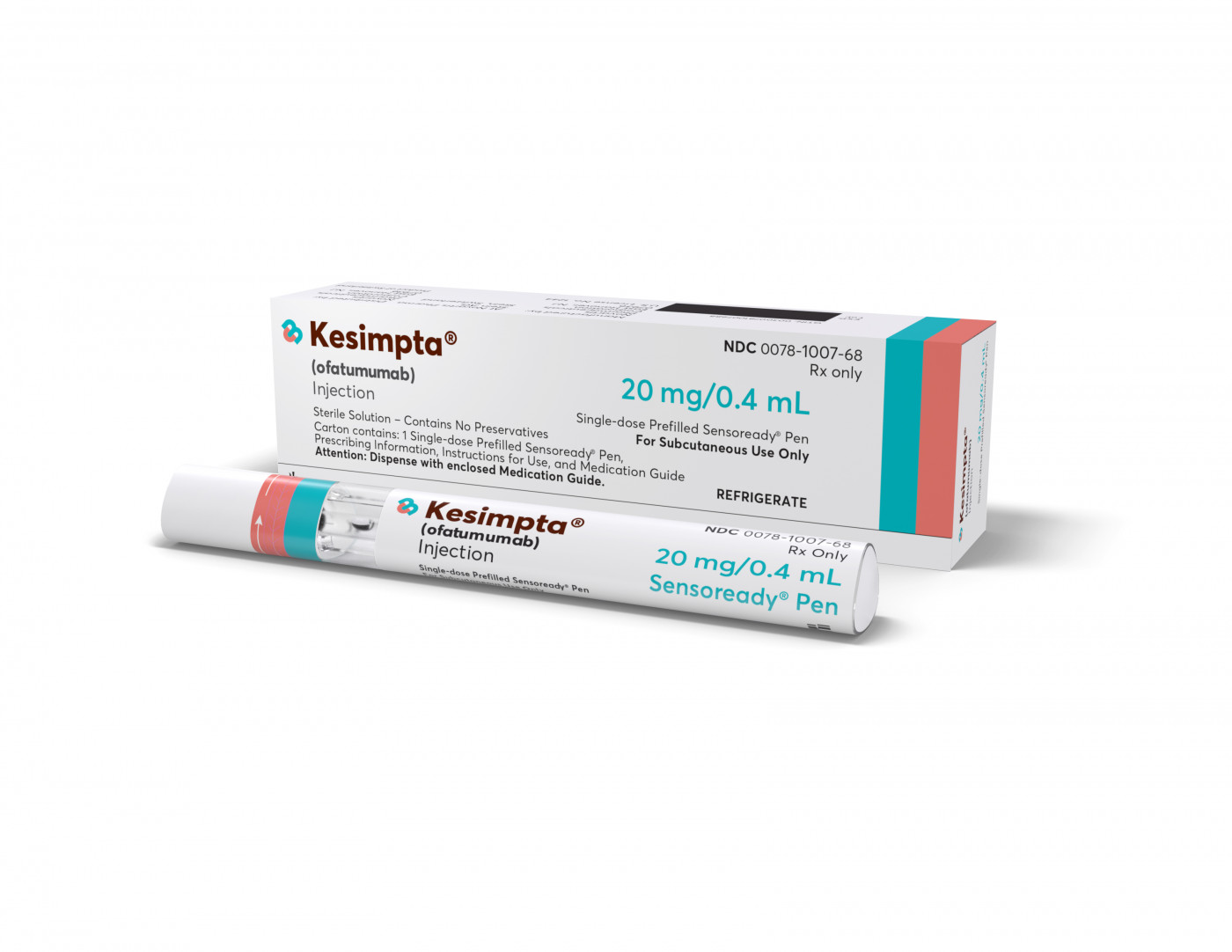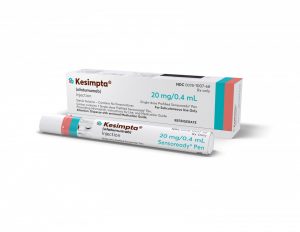Kesimpta Meets Safety, Efficacy and Flexibility Needs of Relapsing MS, Experts Say

Kesimpta, by Novartis, is a once-monthly injection treatment for relapsing MS.
Kesimpta (ofatumumab) is a safe and effective treatment for relapsing multiple sclerosis (MS), with an ease of delivery that makes it more convenient than comparable therapies, experts say.
Developed and marketed by Novartis, Kesimpta was recently approved by the U.S. Food and Drug Administration (FDA) as a treatment for relapsing forms of MS — including clinically isolated syndrome (CIS), relapsing-remitting MS (RRMS), and active secondary progressive MS (SPMS).
 The active agent in Kesimpta is a monoclonal antibody called ofatumumab, which targets CD20, a protein present on the surface of some immune B-cells, to destroy these cells. The therapy was originally developed to treat chronic lymphocytic leukemia (CLL), a B-cell cancer. The FDA approved the medication for CLL, under the brand name Arzerra, in 2009.
The active agent in Kesimpta is a monoclonal antibody called ofatumumab, which targets CD20, a protein present on the surface of some immune B-cells, to destroy these cells. The therapy was originally developed to treat chronic lymphocytic leukemia (CLL), a B-cell cancer. The FDA approved the medication for CLL, under the brand name Arzerra, in 2009.
In recent years, research has shown that B-cells play an important role in the inflammation that causes nervous system damage in MS.
In an interview with MS News Today, Dharmesh Patel, MD, vice president, medical unit head, of neuroscience at Novartis, explained that these findings provided the theoretical basis for developing ofatumumab as a treatment for relapsing MS.
“Like any MS product, the mechanism of action is not completely known … But what we do know is that Kesimpta is specific for CD20 B-cells and it kills those B-cells, and this is how it reduces inflammation in relapsing MS,” Patel said.
“Kesimpta is a completely different formulation [than Arzerra],” he added, “using different routes of administration. And in trials, it seemed to provide strong efficacy, wide safety, and specificity — those three major components that MS patients look for.”
Convenience of at-home injections
Specifically, Kesimpta is administered once monthly by subcutaneous (under-the-skin) injection using the prefilled Sensoready autoinjector pen or a prefilled syringe.
This means that Kesimpta can be administered at home, setting it apart from Arzerra and from other MS therapies that work by depleting B-cells, which are typically delivered by infusion — a process that requires a visit to a hospital or specialty center.
“Kesimpta provides ease of use,” Patel said. “What you have with Kesimpta is a flexibility component; patients can use it in their home or wherever they are. This is a distinguishing feature with other B-cell therapies.”
He also noted that not having to go to a hospital can be cost-saving — both for patients and for the healthcare system as a whole.
“The pluses with Kesimpta is that patients don’t have to go to a healthcare facility, which under certain circumstances, like our current pandemic, becomes a great advantage. You can also administer it at home, allowing for some privacy,” Gabriel Pardo, a neurologist, said in a separate interview with MS News Today.
Pardo is director of the Oklahoma Medical Research Foundation Multiple Sclerosis Center of Excellence — which provides comprehensive care to about 3,000 people with MS — and served as an investigator with one of the ASCLEPIOS clinical trials (NCT02792218 and NCT02792231), results of which formed the basis of Kesimpta’s approval.
Safety and efficacy shown in trials
The ASCLEPIOS trials collectively enrolled 1,882 people with relapsing MS, who were treated with either Kesimpta or Aubagio (teriflunomide), an approved oral relapsing MS treatment marketed by Sanofi Genzyme.
“Aubagio, at the time we were designing this trial, was used as a front-line therapy,” Patel said. He added that using an oral medication for comparison made it easier to blind the trial, since participants given the active injection could also be given dummy pills, and vice versa.
“Another injectable would have made the trial cumbersome for patients, which we didn’t want to do,” he added.
Results from the trials showed that Kesimpta outperformed Aubagio in terms of reducing the annualized relapse rate, limiting disability progression, and decreasing inflammatory brain lesions.
Kesimpta “proved to be significantly effective, or more effective, than [Aubagio]. The primary outcome studied was relapse rates, the relapses resulting from inflammatory activity, [and] saw a comparative reduction of 51% and 58% in the two trials. So, the efficacy was very good,” Pardo said.

Gabriel Pardo, a neurologist and director of the nonprofit research center OMRF. (Courtesy of Dr. Pardo)
Furthermore, “the rate of confirmed three-month disability progression was reduced by almost 35%, and the number of gadolinium enhancing lesions — T1 lesions — by almost 98%, so almost literally eliminating those inflammatory lesions on MRI scans,” Patel added.
A reduction was likewise observed in “new or enlarging lesions [T2 lesions] by almost 85%,” Patel said. “So this is really exciting.”
Results also supported Kesimpta and Aubagio having similar safety profiles. Reported adverse events were generally in line with what is already known about these therapies.
“This is a high efficacy product with similar safety to products currently being used in the U.S. market,” Patel added.
“There was no surprises. I think that’s the first thing to be said about safety,” Pardo said. “We expected adverse events, but there was a relatively low list of infections and a very low percentage of serious adverse events … The safety profile was very good, quite manageable, and perhaps even a little bit better than expected.”
Of note, no cases of progressive multifocal leukoencephalopathy (PML) — a brain infection previously associated with Arzerra and other MS therapies — were reported in clinical trials with Kesimpta.
Arzerra’s doses are “much, much higher,” Pardo said. “We’re talking about 20 mg here versus 1,000 mg for CLL.”
The trials also indicated that patients were generally comfortable doing self-injections at home. After the first four injections, most (74.4%) given Kesimpta administered their own treatment at home.
“With the auto-injector, we saw in clinical trials a high degree of comfort and it was not a major issue,” said Pardo.
A first-line and beyond therapy
Based on the findings, both Patel and Pardo believe Kesimpta has the potential to be a strong first-line treatment for relapsing MS. The idea is that effectively preventing inflammation early in the disease course can limit progressive damage to the nervous system.
“Based on our clinical trials and their full sets of data, we do think Kesimpta should be used at the time of diagnosis,” Patel said. “We definitely do see Kesimpta as a first-line therapy as MS progression starts from the beginning.”
The therapy also shows potential as a later-line treatment in patients previously using other medications. In fact, 60% of participants in the ASCLEPIOS trials switched from other therapies.
“I think when we have this type of good balance between efficacy and safety, it’s a medication that one can consider at any stage of the disease. You can consider it for someone who is naive [to treatment], because the safety concerns are not significant.
“At the same time, the high efficacy would make it very applicable for someone who has already failed at another DMT [disease-modifying therapy],” Pardo said.
“Almost 60% of patients on low-efficacy treatments, they are continuing to experience relapses within one year of beginning a treatment,” Patel said. “So, we think there are a few unmet needs that can be filled by Kesimpta’s arrival in the U.S.”
Choices add to life quality
Kesimpta, with an annual list price reported to be $83,000, is expected to be available in U.S. markets this month. Pardo is planning to prescribe it to some of those he treats.
“I’ve been talking about it for a while actually with some patients,” Pardo said. “People in the MS community are well-informed, they talk among themselves … and reach out for information that is available. Some have been expecting its approval, and will be using it.”
He welcomed the approval of a new relapsing MS therapy, since it means more choices for patients and clinicians.
“Even if they share mechanisms of action, there are enough differences among them that allows us to tailor our therapies in a much better way. Choice enhances our ability to provide a good quality of life,” Pardo said.
“The expectations of providing better care for patients is certainly very satisfying.”
Novartis is seeking approval for Kesimpta beyond the U.S. A decision on an application filed with the European Medicines Agency (EMA) — and possibly with other regulatory agencies — is expected by June 2021, Patel said.
Novartis has opened a patient support program, called Alongside Kesimpta, to provide financial assistance, education, injection training, and other resources to people prescribed the medication. Enrollment is necessary, and the company states that a $0 copay is possible for patients with private insurance, and no government-sponsored prescription drug benefit plan, who sign up for an access card.
“We are excited to bring this innovation to people living with [relapsing] MS in the U.S. … particularly [to] those who can benefit from its strong efficacy, good safety, and the convenience that a patient needs,” Patel said.
“This is a ‘good’ time for MS, as a consequence of understanding this disease better,” Pardo added. “We’re coming out with better strategies, better therapies.”






